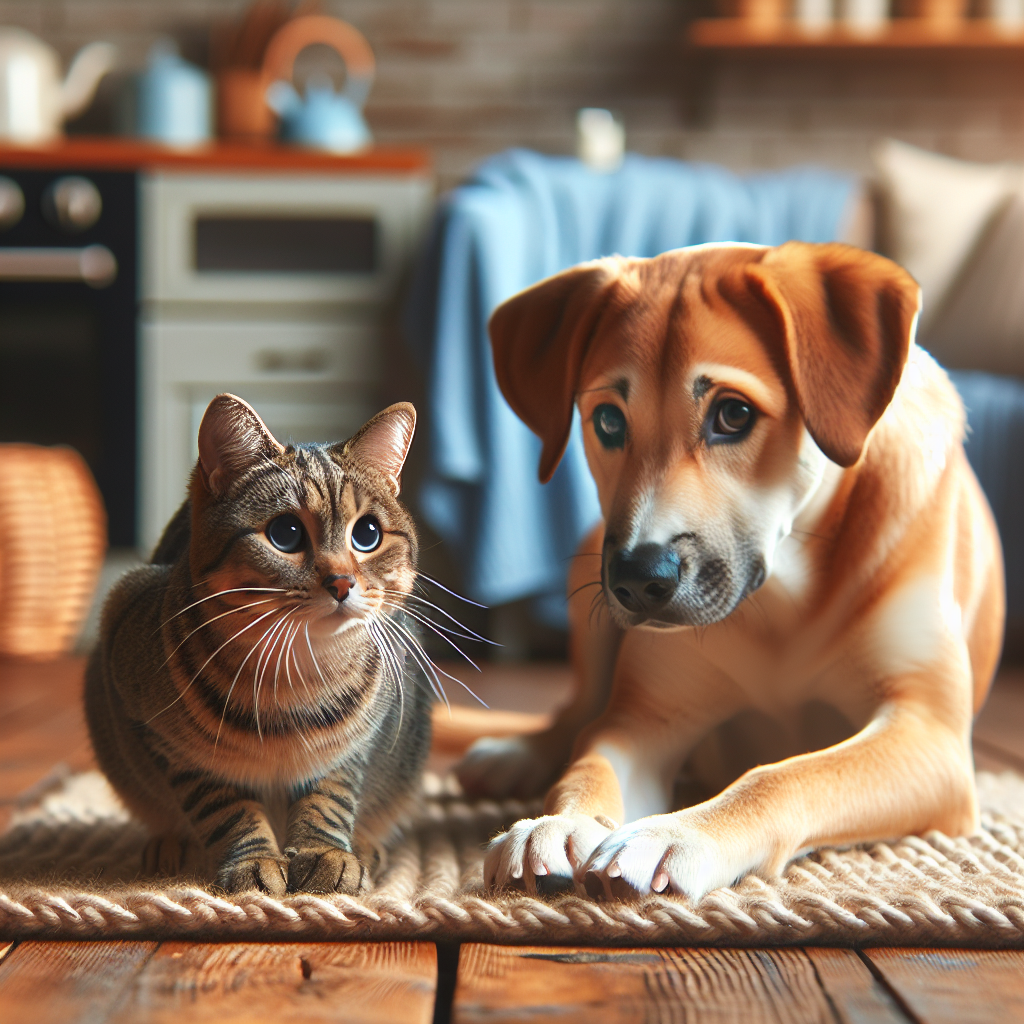If you’ve ever wondered whether tabby cats and dogs can peacefully coexist, you’re not alone. Many pet owners are curious about the compatibility between these two popular pets. While it ultimately depends on the individual personalities of the animals involved, tabby cats are generally known for their friendly and adaptable nature, which can make them more likely to get along with dogs. However, successful introductions and gradual familiarization are key in establishing a harmonious relationship between these furry friends. So, let’s explore how tabby cats and dogs can potentially form a bond that will make your household a happy and peaceful place for all.
Understanding Tabby Cats
Physical Characteristics
Tabby cats are known for their distinctive coat pattern, characterized by a combination of stripes, swirls, and dots. This pattern can be found in different colors, including brown, gray, and orange. Tabby cats usually have a medium to large build, with a muscular body. They have round faces with expressive eyes, and their ears are typically pointed. Overall, tabby cats are renowned for their elegant and attractive appearance.
Temperament
Tabby cats are well-known for their friendly and loving nature. They are often described as affectionate, sociable, and good companions. These cats are highly adaptable and can adjust well to various environments and living situations. Tabby cats enjoy human company and often seek attention and affection. They are generally gentle and amicable, which makes them excellent additions to families with children or other pets.
Social Behavior
Tabby cats exhibit a range of social behaviors. They possess a natural curiosity, exploring their surroundings and engaging in play. These cats are known to be adaptable and can become comfortable with other animals, including dogs, given proper introductions and gradual acclimation. While temperament may vary among individual tabby cats, they are generally sociable creatures and can form strong bonds with both humans and other animals.
Understanding Dogs
Different Breeds and Personalities
Dogs come in various breeds, each with its own unique characteristics and temperaments. Some breeds, such as Labradors and Golden Retrievers, are known for being friendly, sociable, and good with other animals. Other breeds, like certain guarding or hunting breeds, may have more independent or protective tendencies. Understanding the specific breed characteristics and personalities can help in assessing compatibility with tabby cats.
Social Behavior
Dogs are pack animals by nature and have a strong instinct to socialize and form relationships. They thrive on companionship and enjoy the company of both humans and other animals. However, individual dogs may vary in their social behavior due to factors such as breed, upbringing, and past experiences. It is essential to consider each dog’s socialization history and assess their ability to coexist peacefully with other pets.
Training
Training plays a crucial role in a dog’s social behavior and their ability to live harmoniously with other animals. Basic obedience training helps establish boundaries and reinforce good behavior. Dogs that are well-trained and socialized tend to be better equipped to interact positively with tabby cats and other pets.

Introducing Tabby Cats and Dogs
Preparing for the Introduction
Before introducing a tabby cat and a dog, it is essential to prepare the environment for a smooth transition. This includes providing separate safe spaces for both pets, such as separate rooms or crates, where they can retreat to if they feel overwhelmed. Additionally, ensuring that each pet has their own food, water, and litter box or designated outdoor area is crucial for their well-being.
Initial Meeting Techniques
When introducing a tabby cat and a dog, it is crucial to start with brief and controlled interactions. This can be achieved through scent exchange, where each pet’s scent is introduced to the other through blankets or toys. Additionally, visual introductions can be made by using baby gates or crates to create a physical barrier while allowing the pets to see and sniff each other.
Supervised Interactions
Once the initial meetings have taken place, supervised interactions between the tabby cat and dog can begin. This involves closely monitoring their behavior and ensuring that neither pet shows signs of aggression or distress. Gradually increasing the duration of these interactions while keeping a watchful eye is essential. It is important to prioritize the safety and comfort of both the tabby cat and the dog during these supervised interactions.
Signs of Compatibility and Incompatibility
Positive Indicators
Signs of compatibility between a tabby cat and a dog include displays of curiosity and interest in each other, such as sniffing, gentle playfulness, and calm body language. Both pets may engage in mutual grooming or seek each other’s company willingly. These positive indicators suggest that the tabby cat and dog are forming a bond and have the potential for a harmonious relationship.
Negative Indicators
Indicators of incompatibility between a tabby cat and a dog include signs of fear, aggression, or excessive avoidance behavior. Growling, hissing, raised fur, or defensive body postures are red flags that signify a potential problem. It is crucial to address these negative indicators promptly to prevent any harm to the pets or stress within the household.
Addressing Incompatibility
If signs of incompatibility become evident during the introductions, it is vital to seek professional guidance to address the issue. Behaviorists or trainers experienced in cat-dog introductions can provide valuable insights and techniques to facilitate a positive relationship. It may be necessary to separate the tabby cat and dog temporarily and gradually reintroduce them using specialized training methods.

Promoting Positive Relationships
Creating a Safe and Comfortable Environment
To encourage a positive relationship between a tabby cat and a dog, it is essential to create a safe and comfortable environment for both pets. This includes providing hiding spots, vertical space, and elevated resting areas for the tabby cat, ensuring they have places where they feel secure. It is also important to eliminate any potential stressors or triggers that may cause fear or anxiety for either pet.
Establishing Individual Spaces
Having separate areas for each pet is crucial in promoting positive relationships. This ensures that both the tabby cat and dog have their own space where they can relax and retreat to whenever they desire. By respecting their individual boundaries, it reduces the chance of conflicts or unwanted interactions. Each pet should have access to their own bed, toys, and food and water dishes.
Encouraging Bonding Activities
Engaging in bonding activities can help foster a positive relationship between a tabby cat and a dog. Activities such as supervised playtime, gentle training sessions, or interactive feeding can create positive associations and build trust. Additionally, providing opportunities for joint activities such as walks or outdoor adventures can help the tabby cat and dog bond over shared experiences and create a sense of camaraderie.
Training and Socialization
Training Techniques for Cats
While cats are not typically known for extensive training like dogs, they can still benefit from simple commands and learning appropriate behavior. Reward-based training using treats or positive reinforcement can be effective in teaching cats basic commands, such as coming when called or using a scratching post. Training helps cats understand boundaries and expectations, which can contribute to a harmonious coexistence with dogs.
Training Techniques for Dogs
Dogs require consistent and positive reinforcement training to develop good manners and social behaviors. Basic obedience commands like sit, stay, and leave it are essential for ensuring the safety and control of the dog. Positive reinforcement methods, such as clicker training or rewards-based training, can effectively shape desirable behaviors and improve social skills in dogs when interacting with tabby cats.
Socialization Tips for Both
Socialization is crucial for both tabby cats and dogs to ensure they are comfortable and confident in various environments. Gradual exposure to different sounds, sights, smells, and experiences can help them become more well-adjusted. Introducing them to other friendly animals can aid in developing social skills. Consistent positive reinforcement during socialization encourages calm and appropriate behavior, preparing both pets for successful coexistence.
Common Challenges and Solutions
Food and Resource Guarding
Food and resource guarding can be a challenge when introducing a tabby cat and a dog. To mitigate this, it is important to feed each pet in separate locations to prevent any potential conflicts. Providing each pet with their own separate feeding areas and ensuring they have ample space to eat undisturbed can help alleviate food and resource guarding behavior.
Territory Issues
Both tabby cats and dogs have a natural instinct to mark their territories. This can lead to conflicts and territorial disputes when introducing them. To address this challenge, it is recommended to gradually introduce the pets’ scents to each other through scent exchange techniques. This helps familiarize them with each other’s scent and reduces the likelihood of territory-related issues.
Personality Conflicts
Sometimes, personality conflicts can arise between a tabby cat and a dog. If conflicts persist despite gradual introductions and positive reinforcement training, it may be necessary to consult with a behaviorist or trainer. They can provide specialized guidance and techniques to address the specific personality conflicts and help facilitate a harmonious relationship between the tabby cat and dog.
Seeking Professional Assistance
Behaviorists
Behaviorists are professionals who specialize in animal behavior and can provide expert guidance in resolving conflicts or challenges between pets. They can assess the specific dynamics between a tabby cat and a dog and offer tailored solutions to promote positive relationships and address any behavior issues. Behaviorists often employ positive reinforcement and desensitization techniques to modify behavior effectively.
Obedience Trainers
Obedience trainers are experienced professionals who specialize in training dogs to follow commands and behave appropriately. They can play a crucial role in teaching dogs proper manners and social skills, especially when introducing them to a tabby cat. Obedience training can greatly improve a dog’s ability to coexist peacefully with other pets and enhance their overall behavior.
Veterinarians
Veterinarians play an essential role in ensuring the physical well-being of both tabby cats and dogs. When introducing these pets, consulting with a veterinarian can help identify any underlying health issues that may contribute to behavioral challenges. Additionally, veterinarians can provide guidance on vaccination protocols, parasite prevention, and general care to maintain the health and safety of both pets.
Case Studies
Successful Cats and Dogs Coexistence
Numerous case studies highlight the success of introducing tabby cats and dogs. Through patient and gradual introductions, positive reinforcement training, and ongoing supervision, many tabby cats and dogs have formed strong bonds and enjoy each other’s company. These cases demonstrate that with proper understanding, effort, and a commitment to fostering positive relationships, cats and dogs can coexist harmoniously.
Difficulties and Possible Solutions
While successful introductions are common, some cases may present more challenges. Certain tabby cats and dogs may require additional time, specialized training, or professional intervention to overcome compatibility issues. Identifying the specific difficulties and seeking appropriate guidance from behaviorists or trainers can help address these challenges and identify possible solutions to promote a positive relationship.
Conclusion
Importance of Patience and Proper Introductions
Introducing tabby cats and dogs requires patience, understanding, and a gradual approach. Proper introductions, involving scent exchanges, controlled meetings, and supervised interactions, are essential to facilitate a positive relationship between the two pets. By taking the time to establish trust and making the necessary adjustments, the chances of a successful coexistence between tabby cats and dogs significantly increase.
The Rewarding Experience of Tabby Cats and Dogs
Bringing a tabby cat and a dog together can be a rewarding and enriching experience for both pets and their owners. The loving and gentle nature of tabby cats combined with the loyal and sociable nature of dogs can result in a lasting bond. With proper introductions, training, and a commitment to promoting positive relationships, tabby cats and dogs can offer each other companionship, love, and endless enjoyment.

